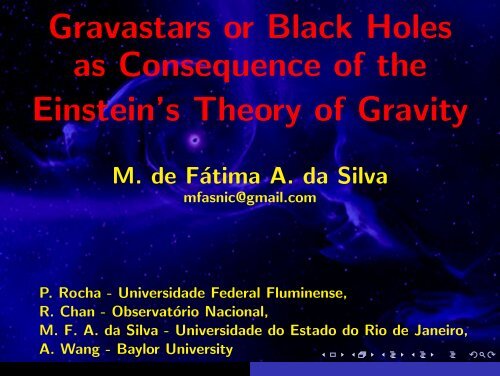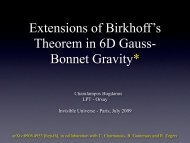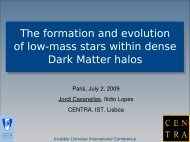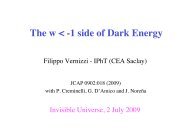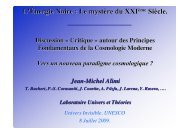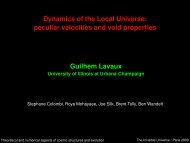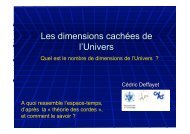Gravastars or Black Holes as Consequence of the Einstein's Theory ...
Gravastars or Black Holes as Consequence of the Einstein's Theory ...
Gravastars or Black Holes as Consequence of the Einstein's Theory ...
You also want an ePaper? Increase the reach of your titles
YUMPU automatically turns print PDFs into web optimized ePapers that Google loves.
<strong>Grav<strong>as</strong>tars</strong> <strong>or</strong> <strong>Black</strong> <strong>Holes</strong><strong>as</strong> <strong>Consequence</strong> <strong>of</strong> <strong>the</strong>Einstein’s The<strong>or</strong>y <strong>of</strong> GravityM. de Fátima A. da Silvamf<strong>as</strong>nic@gmail.comP. Rocha - Universidade Federal Fluminense,R. Chan - Observatório Nacional,M. F. A. da Silva - Universidade do Estado do Rio de Janeiro,A. Wang - Bayl<strong>or</strong> University
IntroductionThe pioneer model <strong>of</strong> grav<strong>as</strong>tar w<strong>as</strong> proposedby Mazur and Mottola (2004), with five layers,◮ an interi<strong>or</strong> de Sitter vacuum
IntroductionThe pioneer model <strong>of</strong> grav<strong>as</strong>tar w<strong>as</strong> proposedby Mazur and Mottola (2004), with five layers,◮ an interi<strong>or</strong> de Sitter vacuum◮ an infinitely thin shell
IntroductionThe pioneer model <strong>of</strong> grav<strong>as</strong>tar w<strong>as</strong> proposedby Mazur and Mottola (2004), with five layers,◮ an interi<strong>or</strong> de Sitter vacuum◮ an infinitely thin shell◮ a finite thin layer (envelope)
IntroductionThe pioneer model <strong>of</strong> grav<strong>as</strong>tar w<strong>as</strong> proposedby Mazur and Mottola (2004), with five layers,◮ an interi<strong>or</strong> de Sitter vacuum◮ an infinitely thin shell◮ a finite thin layer (envelope)◮ ano<strong>the</strong>r infinitely thin shell
IntroductionThe pioneer model <strong>of</strong> grav<strong>as</strong>tar w<strong>as</strong> proposedby Mazur and Mottola (2004), with five layers,◮ an interi<strong>or</strong> de Sitter vacuum◮ an infinitely thin shell◮ a finite thin layer (envelope)◮ ano<strong>the</strong>r infinitely thin shell◮ <strong>the</strong> exteri<strong>or</strong> Schwarzschild vacuum
IntroductionThe pioneer model <strong>of</strong> grav<strong>as</strong>tar w<strong>as</strong> proposedby Mazur and Mottola (2004), with five layers,◮ an interi<strong>or</strong> de Sitter vacuum◮ an infinitely thin shell◮ a finite thin layer (envelope)◮ ano<strong>the</strong>r infinitely thin shell◮ <strong>the</strong> exteri<strong>or</strong> Schwarzschild vacuum◮
Following <strong>the</strong> pioneers, Visser and Wiltshire(2004) adopted a simplifier model with 3layers,◮ an interi<strong>or</strong> de Sitter vacuum
◮ Following <strong>the</strong> pioneers, Visser and Wiltshire(2004) adopted a simplifier model with 3layers,◮ an interi<strong>or</strong> de Sitter vacuum◮ only one infinitely thin shell
◮ Following <strong>the</strong> pioneers, Visser and Wiltshire(2004) adopted a simplifier model with 3layers,◮ an interi<strong>or</strong> de Sitter vacuum◮ only one infinitely thin shell◮ <strong>the</strong> exteri<strong>or</strong> Schwarzschild vacuum
◮ Following <strong>the</strong> pioneers, Visser and Wiltshire(2004) adopted a simplifier model with 3layers,◮ an interi<strong>or</strong> de Sitter vacuum◮ only one infinitely thin shell◮ <strong>the</strong> exteri<strong>or</strong> Schwarzschild vacuum
◮ The equation governing <strong>the</strong> shell’s motion is12ȧ2 + V (a) = 0,
◮ The equation governing <strong>the</strong> shell’s motion is12ȧ2 + V (a) = 0,◮Stable grav<strong>as</strong>tars:V (a 0 ) = 0, V ′ (a 0 ) = 0, V ′′ (a 0 ) > 0. If and only if <strong>the</strong>reexists such an a 0 , <strong>the</strong> model is said to be stable.
◮ The equation governing <strong>the</strong> shell’s motion is12ȧ2 + V (a) = 0,◮◮Stable grav<strong>as</strong>tars:V (a 0 ) = 0, V ′ (a 0 ) = 0, V ′′ (a 0 ) > 0. If and only if <strong>the</strong>reexists such an a 0 , <strong>the</strong> model is said to be stable.”Bounded excursion” grav<strong>as</strong>tars:As VW noticed, <strong>the</strong>re is a less stringent notion <strong>of</strong> stability, <strong>the</strong>so-called ”bounded excursion” models, in which <strong>the</strong>re existtwo radii a 1 and a 2 such thatV (a 1 ) = 0, V ′ (a 1 ) ≤ 0, V (a 2 ) = 0, V ′ (a 2 ) ≥ 0, withV (a) < 0 f<strong>or</strong> a ∈ (a 1 , a 2 ), where a 2 > a 1 .
◮ B<strong>as</strong>ed on <strong>the</strong> discussions about <strong>the</strong> grav<strong>as</strong>tarpicture, many contributions <strong>of</strong> o<strong>the</strong>r auth<strong>or</strong>s canbe found in <strong>the</strong> literature:
◮ B<strong>as</strong>ed on <strong>the</strong> discussions about <strong>the</strong> grav<strong>as</strong>tarpicture, many contributions <strong>of</strong> o<strong>the</strong>r auth<strong>or</strong>s canbe found in <strong>the</strong> literature:◮ C. Cattoen, T. Faber, I. Dymmikova, B. M. N. Carter, O.Bertolami, J. Páramos, De benedictis, C. B. M. H.Chirenti, L. Rezzolla, F. S. N. Lobo and our group,between o<strong>the</strong>rs.
◮ B<strong>as</strong>ed on <strong>the</strong> discussions about <strong>the</strong> grav<strong>as</strong>tarpicture, many contributions <strong>of</strong> o<strong>the</strong>r auth<strong>or</strong>s canbe found in <strong>the</strong> literature:◮ C. Cattoen, T. Faber, I. Dymmikova, B. M. N. Carter, O.Bertolami, J. Páramos, De benedictis, C. B. M. H.Chirenti, L. Rezzolla, F. S. N. Lobo and our group,between o<strong>the</strong>rs.◮ In previous w<strong>or</strong>ks we studied <strong>the</strong> grav<strong>as</strong>tarsmodels proposed by VW (JCAP 6, 25 (2008),JCAP 11, 10 (2008)), and found that, amongo<strong>the</strong>r things, such configurations canindeed be constructed, although <strong>the</strong> regionf<strong>or</strong> <strong>the</strong> f<strong>or</strong>mation <strong>of</strong> <strong>the</strong>se types <strong>of</strong>grav<strong>as</strong>tars is very small in comparison tothat <strong>of</strong> black holes.
◮ Here, we generalize <strong>the</strong>ses results to <strong>the</strong> c<strong>as</strong>ewhere <strong>the</strong> equation <strong>of</strong> state <strong>of</strong> <strong>the</strong> infinitely thinshell is given by p = (1 − γ)σ with γ being aconstant, with an interi<strong>or</strong> phantom/standardenergy fluid (JCAP 03,10 (2009)).
◮ Here, we generalize <strong>the</strong>ses results to <strong>the</strong> c<strong>as</strong>ewhere <strong>the</strong> equation <strong>of</strong> state <strong>of</strong> <strong>the</strong> infinitely thinshell is given by p = (1 − γ)σ with γ being aconstant, with an interi<strong>or</strong> phantom/standardenergy fluid (JCAP 03,10 (2009)).◮ We constructed three-layer dynamical models, inanalogy to <strong>the</strong> VW models, and <strong>the</strong>n, we showthat both types <strong>of</strong> stable grav<strong>as</strong>tars and blackholes exist f<strong>or</strong> several situations. However, we donot find a configuration with a pure dark energyin <strong>the</strong> interi<strong>or</strong>. In <strong>the</strong> ph<strong>as</strong>e space, <strong>the</strong> region <strong>of</strong>grav<strong>as</strong>tars and <strong>of</strong> black holes are non-zero.
Dynamical Three-layer Prototype <strong>Grav<strong>as</strong>tars</strong>The interi<strong>or</strong>: anisotropic dark energy fluid (Lobo’smodel CQG 23, 1525 (2006)) with a metric given byds 2 − = −f 1 dt 2 + f 2 dr 2 + r 2 dΩ 2 ,where dΩ 2 ≡ dθ 2 + sin 2 (θ)dφ 2 , andf 1 = (1 + br 2 ) 1−ω2 (1 + 2br 2 ) ω , f 2 = 1 + 2br 21 + br 2 ,with ¯m(r) = br 32(1+2br 2 )
The c<strong>or</strong>responding energy density ρ, radial andtangential pressures p r and p t are given,respectively, by( ) ( ωb 3 + 2br2p r = ωρ =8πp t = −ωρ + b 2 r { 2 (1 + ω)(3 + 2br 2 ) [ (1 + 3ω) + 2br 2 (1 + ω) ](1 + 2br 2 ) 2 ),−8ω(5 + 2br 2 )(1 + br 2 ) } { 32π [ (1 + 2br 2 ) 3 (1 + br 2 ) ]} .
◮The exteri<strong>or</strong>: spacetime is given by <strong>the</strong> Schwarzschild metricds+ 2 = −fdv 2 + f −1 dr 2 + r 2 dΩ 2 ,where f = 1 − 2m/r.
◮◮The exteri<strong>or</strong>: spacetime is given by <strong>the</strong> Schwarzschild metricwhere f = 1 − 2m/r.ds 2 + = −fdv 2 + f −1 dr 2 + r 2 dΩ 2 ,The thin shell: <strong>the</strong> hypersurface divided <strong>the</strong>se twospacetimes is given by <strong>the</strong> metricdsΣ 2 = −dτ 2 + R 2 (τ)dΩ 2 .Since ( )ds−2 = ( )ds 2 Σ + = Σ ds2 Σ , we find that r Σ = r Σ = R, andf 1 ṫ 2 − f 2 Ṙ 2 = 1, f ˙v 2 − Ṙ 2= 1.f
The interi<strong>or</strong> and exteri<strong>or</strong> extrinsic curvature are given byKττ − = 1 {[2 (1 + bR 2 ) −ω/2 ṫ 4(1 + bR 2 ) ω/2 bR 2 Ṙ 2+2(1 + bR 2 ) ω/2 Ṙ 2 − (1 + 2bR 2 ) ω√ 1 + bR 2 bR 2 ṫ 2−(1 + 2bR 2 ) ω√ 1 + bR 2 ṫ 2 ](2bR 2 ω + 2bR 2 + 3ω + 1)−2(1 + bR 2 ) ω/2 (1 + 2bR 2 )Ṙ 2 }(1 + 2bR 2 ) −2 (1 + bR 2 ) −1 bR + Ṙẗ − ¨Rṫ,K − θθ= ṫ(1 + bR 2 )R1 + 2bR 2 , K − φφ = K − θθ sin2 (θ),K + ττ = ˙v m(4m2 ˙v 2 − 4mR ˙v 2 − 3R 2 Ṙ 2 + R 2 ˙v 2 )(2m − R)R 3 + Ṙ¨v − ¨R ˙v,K + θθ= − ˙v(2m − R), K + φφ = K + θθ sin2 (θ).
◮ From <strong>the</strong> Lake’s w<strong>or</strong>k (PRD 19, 2847 (1979)) we have⇒ [K θθ ] = K + θθ − K − θθ = −M.which furnishes[]√1/2M = −R 1 − 2m 1 + bR 2 + Ṙ 2 (1 + 2bR 2 )R + Ṙ 2 +R(1 + bR 2 ) −(ω+1)/4 (1 + 2bR 2 ) ω+22 ,
◮ From <strong>the</strong> Lake’s w<strong>or</strong>k (PRD 19, 2847 (1979)) we have⇒ [K θθ ] = K + θθ − K − θθ = −M.which furnishes[]√1/2M = −R 1 − 2m 1 + bR 2 + Ṙ 2 (1 + 2bR 2 )R + Ṙ 2 +R(1 + bR 2 ) −(ω+1)/4 (1 + 2bR 2 ) ω+22 ,◮ andṀ+8πRṘϑ = 4πR 2 [T αβ u α n β ] = πR 2 (T + αβ uα +n β + − T − αβ uα −n β −which reduces toṀ + 8πRṘ(1 − γ)σ = 0 ⇒ M = kR 2(γ−1) , if we <strong>as</strong>sume<strong>the</strong> equation <strong>of</strong> state given by ϑ = (1 − γ)σ.),
Recall that 1 2Ṙ 2 + V (R) = 0 ⇒ V (R) = − 1 2Ṙ 2 , we find{V (R, m, ω, b, γ) = −b (ω+2)−2b (3ω+4)/22 R 2(γ−1) b (ω+1)/412 R 4(γ−1) b (ω+1)/21[b (−ω)2 b (ω+1)/21 R 2−b −(ω+1)2 b (ω+3)/21 R 2 − 2b (−ω)2 b (ω+1)/21 mR + b 1 R 2 + b 2 R 2+2b 2 mR + b 2 R 4(γ−1)] 1/2 (ω+2) + b 2 R 2 b (ω+1)/21−b (2ω+3)2 R 2 − 2b (ω+2)2 mRb (ω+1)/21+2b (2ω+3)2 mR + b (2ω+3)2 R 4(γ−1) − b (ω+2)1 R 2} [] } 2+b (ω+1)2 b (ω+3)/21 R 2 /{2R 2 b 2 b (ω+1)2 − b (ω+1)/21 .where b 1 ≡ 1 + bR 2 and b 2 ≡ 1 + 2bR 2 , and we have rescalledm, b, R <strong>as</strong> m → mk − 122γ−3 , b → bk2γ−3 , R → Rk− 12γ−3 .
widthheightcolumns[onlytextwidth]
Clearly, f<strong>or</strong> any given constants m, ω, b and γ, <strong>the</strong> potentialV (R) uniquely determines <strong>the</strong> collapse <strong>of</strong> <strong>the</strong> prototypegrav<strong>as</strong>tar. Depending on <strong>the</strong> initial value R 0 , <strong>the</strong> collapse canf<strong>or</strong>m ei<strong>the</strong>r a black hole, a grav<strong>as</strong>tar, a Minkowski, <strong>or</strong> <strong>as</strong>pacetime filled with phantom fluid.To avoid any kind <strong>of</strong> initial h<strong>or</strong>izons, cosmological <strong>or</strong> event, weimpose R 0 > 2m.Since <strong>the</strong> potential V (R) is so complicated, it is too difficultto study it analytically. Instead, in <strong>the</strong> following we shall studyit numerically. Bef<strong>or</strong>e doing so, we shall present <strong>the</strong>cl<strong>as</strong>sifications <strong>of</strong> matter <strong>as</strong> dark energy <strong>or</strong> phantom energy f<strong>or</strong>anisotropic interi<strong>or</strong> fluid. Taking several values <strong>of</strong> ω in <strong>the</strong>intervals −1 < ω < −1/3 and ω > 0, we could not found anyc<strong>as</strong>e where <strong>the</strong> interi<strong>or</strong> dark energy exist.
Fig 4: In this figure we show <strong>the</strong> intervals <strong>of</strong> ω f<strong>or</strong> which <strong>the</strong> weakand strong energy conditions are independent <strong>of</strong> <strong>the</strong> co<strong>or</strong>dinate Rand <strong>the</strong> parameter b. The condition ρ + p r > 0 is violated f<strong>or</strong>ω < −1, while <strong>the</strong> conditions ρ + p t > 0 and ρ + p r + 2p t > 0 aresatisfied f<strong>or</strong> ω < −1 and −1/3 < ω < 0, f<strong>or</strong> any values <strong>of</strong> R andb. F<strong>or</strong> <strong>the</strong> o<strong>the</strong>rs intervals <strong>of</strong> ω <strong>the</strong> analysis <strong>of</strong> <strong>the</strong> energyconditions depends on a complex relation <strong>of</strong> R and b.
In <strong>or</strong>der to fulfill <strong>the</strong> energy condition σ + 2p ≥ 0 <strong>of</strong> <strong>the</strong> shelland <strong>as</strong>suming that p = (1 − γ)σ we must have γ ≤ 3/2. On<strong>the</strong> o<strong>the</strong>r hand, in <strong>or</strong>der to satisfy <strong>the</strong> condition σ + p ≥ 0, weobtain γ ≤ 2. Hereinafter, we will use only some particularvalues <strong>of</strong> <strong>the</strong> parameter γ which are analyzed in this w<strong>or</strong>k.Table: This table summarizes <strong>the</strong> cl<strong>as</strong>sification <strong>of</strong> matter on <strong>the</strong>thin shell, b<strong>as</strong>ed on <strong>the</strong> energy conditions. The l<strong>as</strong>t columnindicates <strong>the</strong> particular values <strong>of</strong> <strong>the</strong> parameter γ, where we<strong>as</strong>sume that σ ≥ 0.Matter Condition 1 Condition 2 γN<strong>or</strong>mal Matter σ + 2p ≥ 0 σ + p ≥ 0 -1 <strong>or</strong> 0Dark Energy σ + 2p < 0 σ + p ≥ 0 7/4R. Ph. Energy σ + 2p < 0 σ + p < 0 3A. Ph. Energy σ + 2p ≥ 0 σ + p < 0 Not possible
In <strong>the</strong> following we will discuss three physical possibilities f<strong>or</strong><strong>the</strong> type <strong>of</strong> system that can be f<strong>or</strong>med from <strong>the</strong> study <strong>of</strong> <strong>the</strong>potential V (R, m, ω, b, γ):◮ (a) <strong>Black</strong> hole <strong>or</strong> dispersion <strong>of</strong> <strong>the</strong> matter,
In <strong>the</strong> following we will discuss three physical possibilities f<strong>or</strong><strong>the</strong> type <strong>of</strong> system that can be f<strong>or</strong>med from <strong>the</strong> study <strong>of</strong> <strong>the</strong>potential V (R, m, ω, b, γ):◮ (a) <strong>Black</strong> hole <strong>or</strong> dispersion <strong>of</strong> <strong>the</strong> matter,◮ (b) Grav<strong>as</strong>tar <strong>or</strong> n<strong>or</strong>mal star,
In <strong>the</strong> following we will discuss three physical possibilities f<strong>or</strong><strong>the</strong> type <strong>of</strong> system that can be f<strong>or</strong>med from <strong>the</strong> study <strong>of</strong> <strong>the</strong>potential V (R, m, ω, b, γ):◮ (a) <strong>Black</strong> hole <strong>or</strong> dispersion <strong>of</strong> <strong>the</strong> matter,◮ (b) Grav<strong>as</strong>tar <strong>or</strong> n<strong>or</strong>mal star,◮ (c) <strong>Black</strong> hole <strong>or</strong> phantom grav<strong>as</strong>tar.
<strong>Black</strong> Hole <strong>or</strong> Dispersion <strong>of</strong> <strong>the</strong> MatterF<strong>or</strong> m > m c <strong>the</strong> potential V (R) is strictly negative. Then, <strong>the</strong>collapse always f<strong>or</strong>ms black holes. F<strong>or</strong> m = m c , <strong>the</strong>re are twodifferent possibilities, depending on <strong>the</strong> choice <strong>of</strong> <strong>the</strong> initialradius R 0 . In particular, if <strong>the</strong> star begins to collapse withR 0 > R c , it will approach to <strong>the</strong> minimal radius R c . Once itreaches this point, <strong>the</strong> shell will stop collapsing. However, thispoint is unstable and any small perturbations will lead <strong>the</strong> starei<strong>the</strong>r to expand f<strong>or</strong> ever and leave behind a flat spacetime, <strong>or</strong>to collapse until R = 0, whereby a Schwarzschild black hole isfinally f<strong>or</strong>med. On <strong>the</strong> o<strong>the</strong>r hand, if <strong>the</strong> star begins tocollapse with 2m c < R 0 < R c <strong>as</strong> shown in <strong>the</strong> followingfigures, <strong>the</strong> star will collapse until a black hole is f<strong>or</strong>med. F<strong>or</strong>m < m c , <strong>the</strong> potentials V (R) f<strong>or</strong> each c<strong>as</strong>e have a positivemaximal, and <strong>the</strong> equation V (R, m < m c ) = 0 h<strong>as</strong> twopositive roots R 1,2 with R 2 > R 1 > 0.
F<strong>or</strong> <strong>the</strong>se c<strong>as</strong>es <strong>the</strong>re are also two possibilities, depending on<strong>the</strong> choice <strong>of</strong> <strong>the</strong> initial radius R 0 :◮ If R 0 > R 2 , <strong>the</strong> star will first contract to its minimal radiusR = R 2 and <strong>the</strong>n expand to infinity, whereby a spacetimefulfilled by phantom energy fluid is finally f<strong>or</strong>med.
F<strong>or</strong> <strong>the</strong>se c<strong>as</strong>es <strong>the</strong>re are also two possibilities, depending on<strong>the</strong> choice <strong>of</strong> <strong>the</strong> initial radius R 0 :◮ If R 0 > R 2 , <strong>the</strong> star will first contract to its minimal radiusR = R 2 and <strong>the</strong>n expand to infinity, whereby a spacetimefulfilled by phantom energy fluid is finally f<strong>or</strong>med.◮ If 2m < R 0 < R 1 , <strong>the</strong> star will collapse continuously untilR = 0, and a black hole will be finally f<strong>or</strong>med.
C<strong>as</strong>e B:The potential V (R) and <strong>the</strong> energy conditionsEC1≡ ρ + p r + 2p t , EC2≡ ρ + p r and EC3≡ ρ + p t
C<strong>as</strong>e C:The potential V (R) and <strong>the</strong> energy conditionsEC1≡ ρ + p r + 2p t , EC2≡ ρ + p r and EC3≡ ρ + p t
C<strong>as</strong>e H:The potential V (R) and <strong>the</strong> energy conditionsEC1≡ ρ + p r + 2p t , EC2≡ ρ + p r and EC3≡ ρ + p t
C<strong>as</strong>e I:The potential V (R) and <strong>the</strong> energy conditionsEC1≡ ρ + p r + 2p t , EC2≡ ρ + p r and EC3≡ ρ + p t
C<strong>as</strong>e K:The potential V (R) and <strong>the</strong> energy conditionsEC1≡ ρ + p r + 2p t , EC2≡ ρ + p r and EC3≡ ρ + p t
C<strong>as</strong>e L:The potential V (R) and <strong>the</strong> energy conditionsEC1≡ ρ + p r + 2p t , EC2≡ ρ + p r and EC3≡ ρ + p t
Grav<strong>as</strong>tar <strong>or</strong> N<strong>or</strong>mal StarIn this c<strong>as</strong>e we can see that V (R) = 0 now can have one, two<strong>or</strong> three real roots, depending on <strong>the</strong> m<strong>as</strong>s <strong>of</strong> <strong>the</strong> shell. F<strong>or</strong>m > m c we have, say, R i , where R i+1 > R i . If we chooseR 0 > R 3 (f<strong>or</strong> m = m c we have R 2 = R 3 ), <strong>the</strong>n <strong>the</strong> star will notbe allowed in this region because <strong>the</strong> potential is greater than<strong>the</strong> zero. However, if we choose R 1 < R 0 < R 2 , <strong>the</strong> collapsewill bounce back and f<strong>or</strong>th between R = R 1 and R = R 2 . Sucha possibility is shown in <strong>the</strong> following figures. This is exactly<strong>the</strong> so-called ”bounded excursion” model mentioned in VW,and studied in some details in two previous w<strong>or</strong>ks <strong>of</strong> ours. Ofcourse, in a realistic situation, <strong>the</strong> star will emit bothgravitational waves and particles, and <strong>the</strong> potential shall beself-adjusted to produce a minimum at R = R static whereV (R = R static ) = 0 = V ′ (R = R static ) whereby a grav<strong>as</strong>tar <strong>or</strong>a n<strong>or</strong>mal star is finally f<strong>or</strong>med, although we have found, inthat previous w<strong>or</strong>ks, that f<strong>or</strong> <strong>the</strong> grav<strong>as</strong>tar with De Sitter’sinteri<strong>or</strong>, <strong>the</strong> potential tends to −∞ when R tends to ∞.
Here it is completely different since <strong>the</strong> potentialnow tends to +∞ when R tends to ∞. Thus, in<strong>the</strong> c<strong>as</strong>es studied here we do not have situationswhere <strong>the</strong> star expands leaving behind a flatspacetime, <strong>as</strong> in (JCAP 6, 25 (2008), JCAP 11, 10 (2008)).
C<strong>as</strong>e A:The potential V (R) and <strong>the</strong> energy conditionsEC1≡ ρ + p r + 2p t , EC2≡ ρ + p r and EC3≡ ρ + p t
C<strong>as</strong>e G:The potential V (R) and <strong>the</strong> energy conditionsEC1≡ ρ + p r + 2p t , EC2≡ ρ + p r and EC3≡ ρ + p t
<strong>Black</strong> Hole <strong>or</strong> Phantom Grav<strong>as</strong>tarIn this c<strong>as</strong>e <strong>the</strong> potential takes <strong>the</strong> shape given by figurebellow, from which we can see that V (R) = 0 now h<strong>as</strong> fourreal roots, say, R i , where R i+1 > R i . If we choose R 0 > R 4 ,<strong>the</strong>n again <strong>the</strong> star will not be allowed in this region because<strong>the</strong> potential is greater than zero. However, if we chooseR 3 < R 0 < R 4 , <strong>the</strong> collapse will bounce back and f<strong>or</strong>thbetween R = R 3 and R = R 4 , <strong>as</strong> in <strong>the</strong> previous c<strong>as</strong>e. But, ifwe choose R 2 < R 0 < R 3 , we can note that this region isf<strong>or</strong>bidden because ei<strong>the</strong>r <strong>the</strong> potential is imaginary <strong>or</strong> greaterthan zero. However, if we choose R 1 < R 0 < R 2 , <strong>the</strong> collapsewill bounce back and f<strong>or</strong>th between R = R 1 and R = R 2 . IfR 0 < R 1 <strong>the</strong> system will collapse until R = 0, whereby aSchwarzschild black hole is finally f<strong>or</strong>med.
C<strong>as</strong>e J:The potential V (R) and <strong>the</strong> energy conditionsEC1≡ ρ + p r + 2p t , EC2≡ ρ + p r and EC3≡ ρ + p t
C<strong>as</strong>e J:The potential V (R) and <strong>the</strong> energy conditionsEC1≡ ρ + p r + 2p t , EC2≡ ρ + p r and EC3≡ ρ + p t
Table: Summary <strong>of</strong> all possible kind <strong>of</strong> energy <strong>of</strong> <strong>the</strong> interi<strong>or</strong> and <strong>of</strong><strong>the</strong> shell.C<strong>as</strong>e Interi<strong>or</strong> Energy Shell Energy Figures StructuresA Standard Standard 10 N<strong>or</strong>mal StarB Standard Dark 4 BH/DispersionC Standard R. Phantom 5 BH/DispersionD Dark Standard Interi<strong>or</strong> not foundE Dark Dark Interi<strong>or</strong> not foundF Dark R. Phantom Interi<strong>or</strong> not foundG R. Phantom Standard 11 Grav<strong>as</strong>tarH R. Phantom Dark 6 BH/DispersionI R. Phantom R. Phantom 7 BH/DispersionJ A. Phantom Standard 12 Grav<strong>as</strong>tar <strong>or</strong> BHK A. Phantom Dark 8 BH/DispersionL A. Phantom R. Phantom 9 BH/Dispersion
Conclusions◮ We have studied <strong>the</strong> problem <strong>of</strong> <strong>the</strong> stability <strong>of</strong> grav<strong>as</strong>tarsby constructing dynamical three-layer models <strong>of</strong> VW,which consists <strong>of</strong> an internal phantom fluid, a dynamicalinfinitely thin shell <strong>of</strong> perfect fluid with <strong>the</strong> equation <strong>of</strong>state p = (1 − γ)σ, and an external Schwarzschild space.
Conclusions◮ We have studied <strong>the</strong> problem <strong>of</strong> <strong>the</strong> stability <strong>of</strong> grav<strong>as</strong>tarsby constructing dynamical three-layer models <strong>of</strong> VW,which consists <strong>of</strong> an internal phantom fluid, a dynamicalinfinitely thin shell <strong>of</strong> perfect fluid with <strong>the</strong> equation <strong>of</strong>state p = (1 − γ)σ, and an external Schwarzschild space.◮ We have shown explicitly that <strong>the</strong> final output can be ablack hole, a ”bounded excursion” stable grav<strong>as</strong>tar, aMinkowski, <strong>or</strong> a phantom spacetime, depending on <strong>the</strong>total m<strong>as</strong>s m <strong>of</strong> <strong>the</strong> system, <strong>the</strong> parameter ω, <strong>the</strong>constant b, <strong>the</strong> parameter γ and <strong>the</strong> initial position R 0 <strong>of</strong><strong>the</strong> dynamical shell.
Conclusions◮ We have studied <strong>the</strong> problem <strong>of</strong> <strong>the</strong> stability <strong>of</strong> grav<strong>as</strong>tarsby constructing dynamical three-layer models <strong>of</strong> VW,which consists <strong>of</strong> an internal phantom fluid, a dynamicalinfinitely thin shell <strong>of</strong> perfect fluid with <strong>the</strong> equation <strong>of</strong>state p = (1 − γ)σ, and an external Schwarzschild space.◮ We have shown explicitly that <strong>the</strong> final output can be ablack hole, a ”bounded excursion” stable grav<strong>as</strong>tar, aMinkowski, <strong>or</strong> a phantom spacetime, depending on <strong>the</strong>total m<strong>as</strong>s m <strong>of</strong> <strong>the</strong> system, <strong>the</strong> parameter ω, <strong>the</strong>constant b, <strong>the</strong> parameter γ and <strong>the</strong> initial position R 0 <strong>of</strong><strong>the</strong> dynamical shell.◮ All <strong>the</strong>se possibilities have non-zero me<strong>as</strong>urements in <strong>the</strong>ph<strong>as</strong>e space <strong>of</strong> m, b, ω, γ and R 0 , although <strong>the</strong> region <strong>of</strong>grav<strong>as</strong>tars is very small in comparison with that <strong>of</strong> blackholes.
It is interesting to note that we can have black hole f<strong>or</strong>mationeven with an interi<strong>or</strong> phantom energy f<strong>or</strong> any given γ.The results obtained here fur<strong>the</strong>r confirm our previous conclusion:Even though <strong>the</strong> existence <strong>of</strong> grav<strong>as</strong>tars cannot becompletely excluded in <strong>the</strong>se dynamical models, ourresults do indicate that, even if grav<strong>as</strong>tars indeedexist, <strong>the</strong>y do not exclude <strong>the</strong> existence <strong>of</strong> blackholes.


